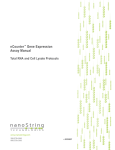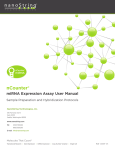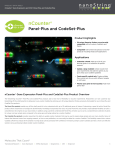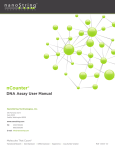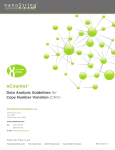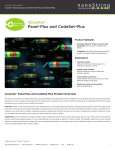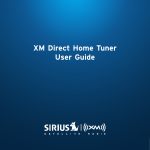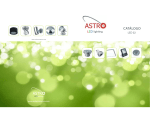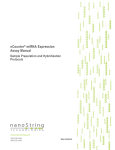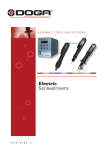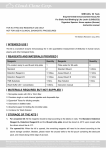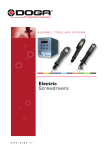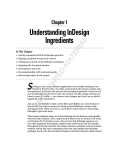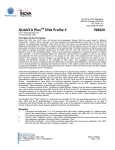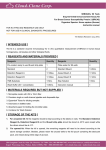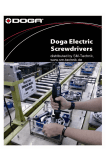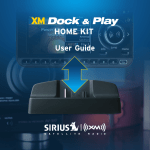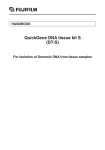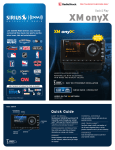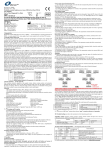Download nCounter® Gene Expression Assay
Transcript
nCounter® Gene Expression Assay User Manual Total RNA and Cell Lysate Protocols NanoString Technologies, Inc. 530 Fairview Ave N Suite 2000 Seattle, Washington 98109 www.nanostring.com Tel: 206.378.6266 888.358.6266 E-mail: [email protected] Molecules That Count® Translational Research Gene Expression miRNA Expression Copy Number Variation MAN-C0003-03 nCounter® Gene Expression Assay USER MANUAL FOR RESEARCH USE ONLY. Not for use in diagnostic procedures. Intellectual Property Rights This nCounter® Analysis System manual and its contents are the property of NanoString Technologies, Inc. (“NanoString”), and is intended solely for the use of NanoString customers, for the purpose of operating the nCounter Analysis System. The nCounter Analysis System (including both its software and hardware components) and this User Guide and any other documentation provided to you by NanoString in connection therewith, are subject to patents, copyright, trade secret rights and other intellectual property rights owned by, or licensed to, NanoString. No part of the software or hardware, may be reproduced, transmitted, transcribed, stored in a retrieval system, or translated into other languages without the prior written consent of NanoString. Limited License Subject to the terms and conditions of the nCounter Analysis System contained in the product quotation, NanoString grants you a limited, nonexclusive, non-transferable, non-sublicensable, research use only license to use the proprietary nCounter Analysis System only in accordance with the manual and other written instructions provided by NanoString. Except as expressly set forth in the terms and conditions, no right or license, whether express, implied or statutory, is granted by NanoString under any intellectual property right owned by, or licensed to, NanoString by virtue of the supply of the proprietary nCounter Analysis System. Without limiting the foregoing, no right or license, whether express, implied or statutory, is granted by NanoString, to use the nCounter Analysis System with any third party product not supplied or licensed to you by NanoString, or recommended for use by NanoString in a manual or other written instruction provided by NanoString. Trademarks NanoString®, NanoString Technologies®, nCounter®, Molecules That Count®, nSolver™, Plex2™, ChIP-String™, miRGE™, and nDesign™ are registered trademarks or trademarks of NanoString Technologies, Inc., (“NanoString”) in the United States and/or other countries. All other trademarks and or service marks not owned by NanoString that appear in this document are the property of their respective owners. Copyright © 2008–2013 NanoString Technologies, Inc. All rights reserved. 2 NanoString™ Technologies USER MANUAL Preface............................................................................................................................................................................................... 4 Conventions Used............................................................................................................................................................. 4 Note Types.......................................................................................................................................................................... 4 Fonts............................................................................................................................................................................. 4 Procedures.......................................................................................................................................................................... 4 Contact Information.......................................................................................................................................................... 4 Chapter 1: Introduction....................................................................................................................................................... 6–10 NanoString Technology.................................................................................................................................................. 6 Principles and Procedures............................................................................................................................... 6 nCounter Gene Expression Assay Overview............................................................................................................. 7 Materials Required........................................................................................................................................................... 8 Materials required for Total RNA Standard Protocol................................................................................ 8 Materials required for Cell Lysate Protocol................................................................................................. 8 Instruments required for Total RNA Standard Protocol and Cell Lysate Protocol........................... 9 Contact Information........................................................................................................................................................ 9 Chapter 2: nCounter® Gene Expression Protocols.................................................................................................10–17 Setting Up 12 nCounter Assays................................................................................................................................... 10 Setting Up a Single nCounter Assay..........................................................................................................................12 Setting Up 24 Plex2 Assays...........................................................................................................................................13 Setting Up 48 Plex2 Assays...........................................................................................................................................15 Molecules That Count® Translational Research Gene Expression miRNA Expression Copy Number Variation 3 nCounter® Gene Expression Assay USER MANUAL The following conventions are used throughout this manual and are described below for your reference: Special font formatting is used in this manual. Such formatting conventions are used in specific instances as described below: Numbered procedures appear frequently providing step-by-step instruction for accomplishing a task. Typically, a numbered step provides direction for a specific action and may be followed by the expected response. Additional information may be presented in the form of a specific note type, bullets, screen capture or other image important to facilitate clarity and understanding. For example: In the (next) screen, the active data entry field is indicated by a green box around it. Simply move from one field to the next, simply press the desired field on the touchscreen with your finger. 1. To add an email address, press ADD. >>> The email address keyboard screen appears. 2. Enter a valid email address and press ENTER. The email address gets saved. NanoString Technologies, Inc. 530 Fairview Ave N Suite 2000 Seattle, Washington 98109 USA 4 Tel: 206.378.6266 888.358.NANO (6266) Fax: 206.378.6288 Email: [email protected] NanoString™ Technologies USER MANUAL This page intentionally left blank. Molecules That Count® Translational Research Gene Expression miRNA Expression Copy Number Variation 5 nCounter® Gene Expression Assay 1 Introduction The nCounter® Gene Expression Assay is designed to provide an sensitive, reproducible and highly multiplexed method for detecting gene expression across all levels of biological expression. This assay provides a method for detecting mRNAs with molecular barcodes called nCounter Reporter Probes without the use of reverse transcription or amplification. This manual describes in detail the methods for setting up nCounter hybridization assays. Please see the nCounter® Prep Station User Manual, nCounter® Digital Analyzer User Manual, and nCounter® Data Analysis Guidelines for instructions on post-hybridization processing and data analysis. This manual covers the nCounter Gene Expression Assay and Plex2 Gene Expression Assay protocols and provides instruction for both the Total RNA Standard Protocol and the Cell Lysate Protocol. The Total RNA Standard Protocol can also be used with total RNA isolated from blood and Formalin-Fixed, Paraffin-Embedded (FFPE) samples. Principles and Procedures NanoString’s technology is based on digital detection and direct molecular barcoding of target molecules through the use of a color coded probe pair. The probe pair consists of a Reporter Probe, which carries the signal on its 5’ end, and a Capture Probe which carries a biotin on the 3’ end. The color codes carry six positions and each position can be one of four colors, thus allowing for a large diversity of tags that can be mixed together in a single well for direct hybridization to target and yet still be individually resolved and identified during data collection. FIGURE 1.1: Capture and Reporter Probes (left) and, Probe pair bound to an mRNA (right) CAPTURE PROBE REPORTER PROBE TARGET-PROBE COMPLEX TARGET 6 NanoString® Technologies NanoString™ Technologies USER MANUAL Probe pairs are placed into a reaction in massive excess to target RNA or DNA species to ensure that each target finds a probe pair. After hybridization, excess probes are washed away using a two step magnetic bead-based purification on the nCounter® Prep Station. Magnetic beads derivatized with short nucleic acid sequences that are complementary to the Capture Probe and the Reporter Probes are used sequentially. First, the hybridization mixture is allowed to bind to the magnetic beads by the Capture Probe. Wash steps are performed and excess Reporter Probes and non-target cellular transcripts are removed during wash steps. After washing, the Capture Probes and Target/Probe complexes are eluted off of the beads and are hybridized to magnetic beads complementary to the Reporter Probe. Wash steps are performed and excess Capture Probes are washed away. Finally, the purified Target/Probe complexes are eluted off and are immobilized in the cartridge for data collection. Data Collection is carried out in the nCounter® Digital Analyzer. At the highest standard data resolution, 555–1155 fields of view (FOV) are collected per flow cell using a microscope objective and a CCD camera yielding data of hundreds of thousands of target molecule counts. Digital images are processed on the nCounter Digital Analyzer and the barcode counts are tabulated in a comma separated value (CSV) format. The nCounter Analysis System was created by NanoString Technologies. The nCounter system is an easy-to-use integrated system that includes a Prep Station (robot) and a Digital Analyzer (analyzer). The Prep Station and the analyzer together make lab work and sample analysis a simpler process by limiting the variables in experiments for lab technicians. The end result is a very precise and accurate measurement, enabling you to gather data on your targets of interest rapidly with minimal intervention. The nCounter Expression Assay is run on the nCounter System. The system is comprised of two instruments, the nCounter Prep Station used for post-hybridization processing, and the Digital Analyzer used for data collection. Follow the instructions on the touchscreen to guide you step-by-step through setting up runs on the Prep Station and Digital Analyzer. FIGURE 1.2: Suggested workflow for the nCounter Expression Assay Day 1 Day 2 Manual Processing Hands-on Time Set Up Hybridization 5 minutes Automated Processing Hands-on Time Set Up Prep Station Run 5 minutes Set Up Data Collection 5 minutes Molecules That Count® Translational Research Gene Expression miRNA Expression Copy Number Variation 7 nCounter® Gene Expression Assay USER MANUAL The following tables list the recommended materials and instrumentation required to run the nCounter Gene Expression Assay. TABLE 1.1: Materials required for Total RNA Standard Protocol Material Manufacturer Part Number nCounter Gene Expression (GX) CodeSet OR nCounter Plex2 Expression Assay Kit NanoString Technologies GXA-P1CS-XXX nCounter Master Kit (GX only) NanoString Technologies NAA-AKIT-XXX *QIAGEN RNeasy® Kit (or similar) QIAGEN 74104 or 74106 Disposable gloves various GXA-2PLX-XXX or GXA-4PLX-XXX Total RNA - 100ng or 150ng per hybridization assay* * If total RNA has been isolated by some other method, please contact NanoString customer support ([email protected]). We highly recommend verifying the integrity of your total RNA samples via denaturing PAGE or Bioanalyzer (Agilent Technologies) before proceeding with hybridization. TABLE 1.2: Materials required for Cell Lysate Protocol Material Manufacturer Part Number nCounter Gene Expression (GX) CodeSet OR nCounter Plex2 Expression Assay Kit NanoString Technologies GXA-P1CS-XXX nCounter Master Kit NanoString Technologies NAA-AKIT-XXX RLT buffer (or similar) QIAGEN* 79216 Disposable gloves various GXA-2PLX-XXX or GXA-4PLX-XXX Cell lysate 2,500 – 15,000 cells per microliter * QIAGEN buffers and a QIAGEN cell lysate procedures (with modifications outlined in Chapter 2) have been tested internally at NanoString Technologies. If using a cell lysis procedure other than QIAGEN’S, please contact NanoString customer support ([email protected]) for additional information. 8 NanoString™ Technologies USER MANUAL TABLE 1.3: Instruments required for Total RNA Standard Protocol and Cell Lysate Protocol Instrument Manufacturer Part Number NanoDrop ND-1000* NanoDrop Technologies n/a Bioanalyzer 2100* Agilent G2940CA Pipette for 0.5 – 10μL* Rainin L-10 Pipette for 2 – 20μL* Rainin L-20 Pipette for 20 – 200μL* Rainin L-200 Tube-Strip Picofuge* Stratagene 400540 DNA engine thermocycler, hybridization oven (or similar) MJ Research / BioRad PTC-200G† PTC-1148† PTC-0220G† PTC-0221G† PTC-0240G† nCounter Prep Station NanoString Technologies NCT-PREP-120 nCounter Digital Analyzer NanoString Technologies NCT-DIGA-120 Memory stick various n/a * nCounter system performance data was generated on model PCT DNA engines. Other instruments may produce non-standard results when used with the nCounter assay. † Any one of these instruments will meet the requirements of the nCounter Assay. NanoString Technologies, Inc. 530 Fairview Ave N Suite 2000 Seattle, Washington 98109 Tel: (888) 358-6266 Fax: (206) 378-6288 E-mail: [email protected] Molecules That Count® Translational Research Gene Expression miRNA Expression Copy Number Variation 9 nCounter® Gene Expression Assay 2 nCounter® Gene Expression Protocols This chapter outlines the nCounter Gene Expression Assay protocol and provides instruction for both the Total RNA Standard Protocol and the Cell Lysate Protocol. Instruction for setting up 12 nCounter Assays or a single nCounter Assay are provided. GENERAL PROBE HANDLING WARNING: During setup of your assay, do not vortex or pipet vigorously to mix as it may shear the Reporter Probes. Mixing should be done by flicking or inverting the tubes. Also, if you use a microfuge to spin down tubes, do not spin any faster than 1,000 rpm for more than 30 seconds and do not “pulse” it to spin because that will cause the centrifuge to go to maximum speed and you may spin your CodeSet out of solution. The final hybridization reaction will contain the following components: 10μL Reporter CodeSet, 10μL hybridization buffer, a total volume of 5μL of sample RNA (100ng), and 5μL Capture ProbeSet. The order of addition of components is important, please follow the protocol exactly. 1. If following the Total RNA Standard Protocol go to Step 3. 2. If following the Cell Lysate Protocol: Lyse Cells according to Qiagen recommendations (see Qiagen RNeasy Mini Handbook, supplied with product numbers 74104 and 74106) with the following modifications: a. Cells should be lysed at concentration between 2,500 and 10,000 cells/μL of RLT buffer. The nCounter cell lysate hybridization procedure has been optimized for ~10,000 mammalian cells/reaction or the equivalent of approximately 100ng of total RNA. b. Cell lysates should be aliquoted and stored at –80°C. Avoid freeze/thaw cycles. 3. Remove aliquots of both Reporter CodeSet and Capture ProbeSet reagent from the freezer and thaw on ice. Invert several times to mix well and spin down reagent. IMPORTANT: After it has thawed, inspect the tube of Reporter CodeSet to make sure no colored precipitate is present. If you see a colored precipitate, heat the entire tube to 75°C for 10 minutes and cool at room temperature before using. 4. Create a master mix by adding 130μL of hybridization buffer to the tube of Reporter Probes. Do not remove the Reporter Probes from tube. RNAse-free water may also be added to this mix if the volume of the individual RNA samples is less than 5μL and is constant. (Add enough water for 13 assays to allow one assay’s worth of dead volume.) Do not add the Capture ProbeSet to the master mix. Invert to mix and spin down master mix. 10 NanoString® Technologies NanoString™ Technologies USER MANUAL 5. Label a provided 12 tube strip and cut it in half so it will fit in a picofuge. 6. Add 20μL of mastermix to each of the 12 tubes (if you added water to the master mix, adjust volumes). It is advisable to use a fresh tip for each pipetting step to accurately pipet the correct volume. The CodeSet has components that can start to wick up into the tip and not dispense the correct amount if you use the same tip to dispense master mix into all of the hybridization tubes. 7. Add sample according to your protocol type as follows: a. If following the Total RNA Standard Protocol: Add total RNA sample (maximum volume 5μL) for a total of 100ng to each tube. Go to Step 8. b. If following the Cell Lysate Protocol: Add cell lysate sample (maximum volume 4μL) for a total of approximately 10,000 cells per hybridization assay. Using less than 10,000 cells/reaction will result in fewer counts/gene. c. If using attenuation mix(es), add 1μL of each mix. Note: this reagent can also be added to the master mix if all reactions are to be attenuated. 8. If necessary, add RNAse-free water to each tube to bring the volume of each assay to 25μL. 9. Pre-heat thermocycler to 65°C. Program the thermocycler using 30μL volume, calculated temperature, heated lid and “forever” time setting. Do not set the thermocycler to ramp down to 4°C at the end of the run. If a thermocycler is not available, a 65°C hybridization oven may be used. (The use of a thermocycler is recommended if possible. Due to less stringent temperature control, assay results may be more variable in a hybridization oven.) To use a hybridization oven, place a large beaker full of water in the oven to ensure a humid environment. Do not place the samples in the water beaker; evaporative loss causes the water temperature to be below the air temperature in the oven. Place the samples in a dry rack in the middle of the oven shelf, or tape the strip tubes to a rotator in the center of the oven. Make sure that the strip tubes and/or rack do not touch the sides or bottom of the oven. Failure to follow these instructions may result in uneven hybridization temperatures which can compromise the results. 10. Add 5μL of Capture ProbeSet to each tube immediately before placing at 65°C. Cap tubes and mix the reagents by inverting the strip tubes several times and flicking with your finger to ensure complete mixing. Briefly spin down and immediately place the strip tube in the 65°C thermocycler. Minimizing the time between the addition of the Capture ProbeSet and the placement of the reaction at 65°C will increase the sensitivity of your assay. 11. Incubate hybridization assays for at least 12 hours. Hybridizations should be left at 65°C until ready for processing. Maximum hybridization time should not exceed 30 hours. 12. Once removed from the thermocycler, proceed immediately to post-hybridization processing with the nCounter Prep-station. Do not store hybridizations at 4°C. Molecules That Count® Translational Research Gene Expression miRNA Expression Copy Number Variation 11 nCounter® Gene Expression Assay USER MANUAL During setup of your assay, do not vortex or pipet vigorously to mix as it may shear the Reporter Probes. Mixing should be done by flicking or inverting the tubes. Also, if you use a microfuge to spin down tubes, do not spin any faster than 1,000 rpm for more than 30 seconds and do not “pulse” it to spin because that will cause the centrifuge to go to maximum speed and you may spin your CodeSet out of solution. The final hybridization reaction will contain the following components: 10μL Reporter CodeSet, 10μL hybridization buffer, a total volume of 5μL of sample RNA (100ng), and 5μL Capture ProbeSet. If you are making a master mix of any components, DO NOT include the Capture ProbeSet. It is important that the Capture ProbeSet be added individually to each assay, immediately before the reaction is transferred to 65°C. 1. If following the Total RNA Standard Protocol go to Step 3. 2. If following the Cell Lysate Protocol: Lyse Cells according to Qiagen recommendations (see Qiagen RNeasy Mini Handbook, supplied with product numbers 74104 and 74106) with the following modifications: a. Cells should be lysed at concentration between 2,500 and 10,000 cells/μL of RLT buffer. The nCounter cell lysate hybridization procedure has been optimized for ~10,000 mammalian cells/reaction or the equivalent of approximately 100ng of total RNA. b. Cell lysates should be aliquoted and stored at –80°C. Avoid freeze/thaw cycles. 3. Remove aliquots of both Reporter CodeSet and Capture ProbeSet reagent from the freezer and thaw on ice. Invert several times to mix well and spin down reagent. IMPORTANT: After it has thawed, inspect the tube of Reporter CodeSet to make sure no colored precipitate is present. If you see a colored precipitate, heat the entire tube to 75°C for 10 minutes and cool at room temperature before using. 4. Label a provided 12 tube strip and cut it in half so it will fit in a picofuge. 5. Add 10μL of Reporter CodeSet reagent to each tube. Store remaining Reporter CodeSet at 4°C for up to 1 month. 6. Add 10μL of hybridization buffer to each tube. 7. Add sample according to your protocol type as follows: a. If following the Total RNA Standard Protocol: Add total RNA sample (maximum volume 5μL) for a total of 100ng to each tube. Go to Step 8. b. If following the Cell Lysate Protocol: Add cell lysate sample (maximum volume 4μL) for a total of approximately 10,000 cells per hybridization assay. Using less than 10,000 cells/reaction will result in fewer counts/gene. c. If using attenuation mix(es), add 1μL of each mix. 8. Add RNAse-free water to each tube to bring the volume of each assay to 25μL. 9. Pre-heat thermocycler to 65°C. Program the thermocycler using 30μL volume, calculated temperature, heated lid and “forever” time setting. Do not set the thermocycler to ramp down to 4°C at the end of the run. Alternatively, a 65°C hybridization oven may be used when a large beaker full of water is placed in the oven to ensure a humid environment. 10. Add 5μL of Capture ProbeSet to each tube immediately before placing at 65°C. Cap tubes and mix the reagents by inverting the strip tubes several times and flicking with your finger to ensure complete mixing. Briefly spin down and immediately place the strip tube in the 65°C thermocycler. Minimizing the time between the addition of the Capture ProbeSet and the placement of the reaction at 65°C will increase the sensitivity of your assay. 11. Store remaining Capture ProbeSet at 4°C for up to 1 month. 12. Incubate hybridization assays for at least 12 hours. Hybridizations should be left at 65°C until ready for processing. Maximum hybridization time should not exceed 30 hours. 13. Once removed from the thermocycler, proceed immediately to post-hybridization processing with the nCounter Prep Station. Do not store hybridizations at 4°C. 12 NanoString™ Technologies USER MANUAL This section outlines the nCounter Plex2 Expression Assay protocol and provides instruction for both the Total RNA Standard Protocol and the Cell Lysate Protocol. Instruction for setting up 24 and 48 Plex2 Assays (1 cartridge) is also provided. GENERAL PROBE HANDLING WARNING: During setup of your assay, do not vortex or pipet vigorously to mix as it may shear the Reporter Probes. Mixing should be done by flicking or inverting the tubes. Also, if you use a microfuge to spin down tubes, do not spin any faster than 1,000 rpm for more than 30 seconds and do not “pulse” it to spin because that will cause the centrifuge to go to maximum speed and you may spin your CodeSet out of solution. IMPORTANT: To facilitate downstream analysis in the nSolver Analysis System, the same sample (Calibration sample) must be run across both CodeSets in the same lane at least once per study (see Figure 2.1). This means that you must hybridize the same Calibration sample in both sub-CodeSets one time. For more information on the Calibration sample see the nCounter Expression Data Analysis Guidelines. FIGURE 2.1: Hybridization setup To facilitate downstream analysis in the nSolver Analysis System a Calibration sample must be assayed across both Sub-CodeSets in a single lane at least one time per study. In the figure below CS signifies a Sub-CodeSet (CS1–CS2). A single reference sample (red tube marked one) is assayed in each Sub-CodeSet once per study. All other tubes contain unique samples. IMPORTANT: Be sure to only mix only unique sub-CodeSets in a single tube. Use any given sub-CodeSet only one time in a single lane of the cartridge. The final hybridization reaction will contain the following components: 10μL Reporter CodeSet, 10μL hybridization buffer, a total volume of 5μL of sample RNA (100ng), and 5μL Capture ProbeSet. The order of addition of components is important, please follow the protocol exactly. 1. If following the Total RNA Standard Protocol go to Step 3. 2. If following the Cell Lysate Protocol: Lyse Cells according to Qiagen recommendations (see Qiagen RNeasy Mini Handbook, supplied with product numbers 74104 and 74106) with the following modifications: a. Cells should be lysed at concentration between 2,500 and 10,000 cells/μL of RLT buffer or similar. The nCounter cell lysate hybridization procedure has been optimized for ~10,000 mammalian cells/reaction or the equivalent of approximately 100ng of total RNA. b. Cell lysates should be aliquoted and stored at –80°C. Avoid freeze/thaw cycles. 3. Remove aliquots of both Reporter CodeSet and Capture ProbeSet reagent from the freezer and thaw on ice. Invert several times to mix well and spin down reagent. IMPORTANT: After it has thawed, inspect the tube of Reporter CodeSet to make sure no colored precipitate is present. If you see a colored precipitate, heat the entire tube to 75°C for 10 minutes and cool at room temperature before using. Molecules That Count® Translational Research Gene Expression miRNA Expression Copy Number Variation 13 nCounter® Gene Expression Assay USER MANUAL 4. Create a master mix by adding 130μL of hybridization buffer to the tube of Reporter Probes. Do not remove the Reporter Probes from tube. RNAse-free water may also be added to this mix if the volume of the individual RNA samples is less than 5μL and is constant. (Add enough water for 13 assays to allow one assay’s worth of dead volume.) Do not add the Capture ProbeSet to the master mix. Invert to mix and spin down master mix. 5. Label two provided 12 tube strip tubes and cut each in half so it will fit in a picofuge. 6. Add 20μL of mastermix to each of the 24 tubes (if you added water to the master mix, adjust volumes). It is advisable to use a fresh tip for each pipetting step to accurately pipet the correct volume. The CodeSet has components that can start to wick up into the tip and not dispense the correct amount if you use the same tip to dispense master mix into all of the hybridization tubes. 7. Add sample according to your protocol type as follows: a. If following the Total RNA Standard Protocol: Add total RNA sample (maximum volume 5μL) for a total of 100ng to each tube. Go to Step 8. b. If following the Cell Lysate Protocol: Add cell lysate sample (maximum volume 4μL) for a total of approximately 10,000 cells per hybridization assay. Using less than 10,000 cells/reaction will result in fewer counts/gene. c. If using attenuation mix(es), add 1μL of each mix. Note: this reagent can also be added to the master mix if all reactions are to be attenuated. 8. If necessary, add RNAse-free water to each tube to bring the volume of each assay to 25μL. 9. Pre-heat thermocycler to 65°C. Program the thermocycler using 30μL volume, calculated temperature, heated lid and “forever” time setting. Do not set the thermocycler to ramp down to 4°C at the end of the run. If a thermocycler is not available, a 65°C hybridization oven may be used. (The use of a thermocycler is recommended if possible. Due to less stringent temperature control, assay results may be more variable in a hybridization oven.) To use a hybridization oven, place a large beaker full of water in the oven to ensure a humid environment. Do not place the samples in the water beaker; evaporative loss causes the water temperature to be below the air temperature in the oven. Place the samples in a dry rack in the middle of the oven shelf, or tape the strip tubes to a rotator in the center of the oven. Make sure that the strip tubes and/or rack do not touch the sides or bottom of the oven. Failure to follow these instructions may result in uneven hybridization temperatures which can compromise the results. 10. Add 5μL of Capture ProbeSet to each tube immediately before placing at 65°C. Cap tubes and mix the reagents by inverting the strip tubes several times and flicking with your finger to ensure complete mixing. Briefly spin down and immediately place the strip tube in the 65°C thermocycler. Minimizing the time between the addition of the Capture ProbeSet and the placement of the reaction at 65°C will increase the sensitivity of your assay. 11. Incubate hybridization assays for at least 12 hours. Hybridizations should be left at 65°C until ready for processing. Maximum hybridization time should not exceed 30 hours. 12. Remove tubes from the thermocycler, and combine full hybridization volumes of strip tubes 1 and 2 into strip tube 1, as shown in Figure 2.2, maintaining tube orientation. The resulting final volume is 60μL per well. 13. Once removed from the thermocycler, recap tubes, briefly spin, and proceed immediately to post-hybridization processing with the nCounter Prep Station. Do not store hybridizations at 4°C. FIGURE 2.2: Post-hybridization mixing step Post-hybridization, add full hybridization reaction volume from CS2 into the CS1 tube, maintaining tube orientation. The resulting final volume is 60μL per well. In the figure above, hybridization volumes from CS2 are combined into the CS1 strip tube. The CS1 strip tube is then recapped and briefly spun before loading into the Prep Station. 14 NanoString™ Technologies USER MANUAL GENERAL PROBE HANDLING WARNING: During setup of your assay, do not vortex or pipet vigorously to mix as it may shear the Reporter Probes. Mixing should be done by flicking or inverting the tubes. Also, if you use a microfuge to spin down tubes, do not spin any faster than 1,000 rpm for more than 30 seconds and do not “pulse” it to spin because that will cause the centrifuge to go to maximum speed and you may spin your CodeSet out of solution. IMPORTANT: To facilitate downstream analysis in the nSolver Analysis System, the same sample (Calibration sample) must be run across both CodeSets in the same lane at least once per study (see Figure 2.3). This means that you must hybridize the same Calibration sample in both sub-CodeSets one time. For more information on the Calibration sample see the nCounter Expression Data Analysis Guidelines. FIGURE 2.3: Hybridization setup To facilitate downstream analysis in the nSolver Analysis System a Calibration sample must be assayed across all four Sub-CodeSets in a single lane at least one time per study. In the figure below CS signifies a Sub-CodeSet (CS1–CS4). A single Calibration sample (red tube marked one) is assayed in each Sub-CodeSet at least once per study. All other tubes contain unique samples. IMPORTANT: Be sure to only mix only unique sub-CodeSets in a single tube. Use any given sub-CodeSet only one time in a single lane of the cartridge. The final hybridization reaction will contain the following components: 10μL Reporter CodeSet, 10μL hybridization buffer, a total volume of 5μL of sample RNA (150ng), and 5μL Capture ProbeSet. The order of addition of components is important, please follow the protocol exactly. 1. If following the Total RNA Standard Protocol go to Step 3. 2. If following the Cell Lysate Protocol: Lyse Cells according to Qiagen recommendations (see Qiagen RNeasy Mini Handbook, supplied with product numbers 74104 and 74106) with the following modifications: a. Cells should be lysed at concentration between 3,500 and 15,000 cells/μL of RLT buffer. The nCounter Plex2 cell lysate hybridization procedure has been optimized for ~15,000 mammalian cells/reaction or the equivalent of approximately 150ng of total RNA. b. Cell lysates should be aliquoted and stored at –80°C. Avoid freeze/thaw cycles. Molecules That Count® Translational Research Gene Expression miRNA Expression Copy Number Variation 15 nCounter® Gene Expression Assay USER MANUAL 3. Remove aliquots of both Reporter CodeSet and Capture ProbeSet reagent from the freezer and thaw on ice. Invert several times to mix well and spin down reagent. IMPORTANT: After it has thawed, inspect the tube of Reporter CodeSet to make sure no colored precipitate is present. If you see a colored precipitate, heat the entire tube to 75°C for 10 minutes and cool at room temperature before using. 4. Create a master mix for each sub-CodeSet by adding 130μL of hybridization buffer to the tube of Reporter Probes for each CodeSet. Do not remove the Reporter Probes from tube. RNAse-free water may also be added to this mix if the volume of the individual RNA samples is less than 5μL and is constant. (Add enough water for 13 assays to allow one assay’s worth of dead volume.) Do not add the Capture ProbeSet to the master mix. Invert to mix and spin down master mix. 5. Label four provided 12 tube strip tubes and cut each in half so it will fit in a picofuge. 6. Add 20μL of mastermix to each of the tubes (if you added water to the master mix, adjust volumes). It is advisable to use a fresh tip for each pipetting step to accurately pipet the correct volume. The CodeSet has components that can start to wick up into the tip and not dispense the correct amount if you use the same tip to dispense master mix into all of the hybridization tubes. 7. Add sample according to your protocol type as follows: a. If following the Total RNA Standard Protocol: Add total RNA sample (maximum volume 5μL) for a total of 150ng to each tube. Go to Step 8. b. If following the Cell Lysate Protocol: Add cell lysate sample (maximum volume 4μL) for a total of approximately 15,000 cells per hybridization assay. Using less than 15,000 cells/reaction will result in fewer counts/gene. c. If using attenuation mix(es), add 1μL of each mix. Note: this reagent can also be added to the master mix if all reactions are to be attenuated. 8. If necessary, add RNAse-free water to each tube to bring the volume of each assay to 25μL. 9. Pre-heat thermocycler to 65°C. Program the thermocycler using 30μL volume, calculated temperature, heated lid and “forever” time setting. Do not set the thermocycler to ramp down to 4°C at the end of the run. If a thermocycler is not available, a 65°C hybridization oven may be used. (The use of a thermocycler is recommended if possible. Due to less stringent temperature control, assay results may be more variable in a hybridization oven.) To use a hybridization oven, place a large beaker full of water in the oven to ensure a humid environment. Do not place the samples in the water beaker; evaporative loss causes the water temperature to be below the air temperature in the oven. Place the samples in a dry rack in the middle of the oven shelf, or tape the strip tubes to a rotator in the center of the oven. Make sure that the strip tubes and/or rack do not touch the sides or bottom of the oven. Failure to follow these instructions may result in uneven hybridization temperatures which can compromise the results. 10. Add 5μL of Capture ProbeSet to each tube immediately before placing at 65°C. Cap tubes and mix the reagents by inverting the strip tubes several times and flicking with your finger to ensure complete mixing. Briefly spin down and immediately place the strip tube in the 65°C thermocycler. Minimizing the time between the addition of the Capture ProbeSet and the placement of the reaction at 65°C will increase the sensitivity of your assay. 11. Incubate hybridization assays for at least 12 hours. Hybridizations should be left at 65°C until ready for processing. Maximum hybridization time should not exceed 30 hours. 16 NanoString™ Technologies USER MANUAL 12. Remove tubes from the thermocycler, and combine full hybridization volumes of strip tubes CS2, CS3, and CS4 into CS1 (strip tube 1), as shown in Figure 2.4, maintaining tube orientation. The resulting final volume is 120μL per well. 13. Once removed from the thermocycler, recap, and briefly spin tubes before proceeding immediately to post-hybridization processing with the nCounter Prep Station. Do not store hybridizations at 4°C. FIGURE 2.4: Post-hybridization mixing step Post-hybridization, add full hybridization reaction volume from CS2, CS3, and CS4 into the CS1 tube, maintaining tube orientation. The resulting final volume is 120μL per well. In the figure above, hybridization volumes from CS1, CS2, and CS3 are combined into the CS1 strip tube. The CS1 strip tube is then recapped, briefly spun, and loaded into the Prep Station. Molecules That Count® Translational Research Gene Expression miRNA Expression Copy Number Variation 17 USER MANUAL nCounter® Gene Expression Assay NanoString Technologies, Inc. CONTACT US SALES CONTACTS 530 Fairview Ave N Suite 2000 Seattle, Washington 98109 [email protected] United States:[email protected] Tel: (888) 358-6266 Europe:[email protected] Fax: (206) 378-6288 Other Regions:[email protected] www.nanostring.com © 2013 NanoString Technologies, Inc. All rights reserved. NanoString®, NanoString Technologies®, nCounter®, Molecules That Count®, nSolver™, Plex2™, ChIP-String™, miRGE™, and nDesign™ are registered trademarks or trademarks of NanoString Technologies, Inc., (“NanoString”) in the United States and/or other countries. All other trademarks and or service marks not owned by NanoString that appear in this document are the property of their respective owners. The manufacture, use and or sale of NanoString product(s) may be subject to one or more patents or pending patent applications owned by NanoString or licensed to NanoString from Life Technologies Corporation and other third parties. FOR RESEARCH USE ONLY. Not for use in diagnostic procedures. 20131213 | MAN-C0003-03


















